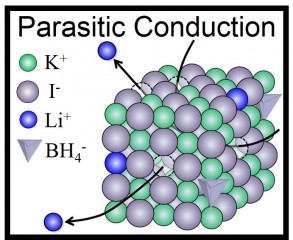New Lithium Battery Created in Japan

Hitoshi Takamura/Tohoku Univ. Synthesis of cubic LiBH4 at ambient pressure and Parasitic Conduction Mechanism exhibited in KI - LiBH4 solid solution
The long life of lithium ion batteries makes them the rechargeable of choice for everything from implantable medical devices to wearable consumer electronics. But lithium ion batteries rely on liquid chemistries involving lithium salts dissolved in organic solvents, creating flame risks that would be avoided if the cells were completely solid-state.
Now a team of researchers at Tohoku University in Japan has created a new type of lithium ion conductor for future batteries that could be the basis for a whole new generation of solid-state batteries. It uses rock salt Lithium Borohydride (LiBH4), a well-known agent in organic chemistry laboratories that has been considered for batteries before, but up to now has only worked at high temperatures or pressures.
In the journal APL Materials, from AIP Publishing, the researchers describe how they doped a cubic lattice of KI molecules with the LiBH4. This allowed them to stabilize the high-pressure form of Lithium borohydride and make a solid solution at normal atmospheric pressure that was stable at room temperature.
In making the new technology, the team made the peculiar discovery that the Li+ ions functioned like pure Li+ ion conductors, even though they were just doping the KI lattices. This is the reverse of the normal doping technique, in which a small amount of stabilizing element would be added to an ionic conductor abundant in Lithium.
“In other words, LiBH4 is a sort of 'parasite' but not a host material,” said Hitoshi Takamura who led the research at Tohoku University. He and his colleagues have called this mechanism “parasitic conduction” and have suggested that it could be broadly applied in the search for new batteries — anywhere that small amounts of Li+ ions could be used to dope an oxide, sulfide, halide or nitride host material.
“This work suggests the potential of this mechanism in the ongoing search for the perfect material for use in solid state batteries,” added Takamura. “The urgency of this quest has been abundantly clear after the grounding of so many aircraft in recent months.”
The article “Synthesis of Rock-Salt Type Lithium Borohydride and Its Peculiar Li+ Ion Conduction Properties” is authored by R. Miyazaki, H. Maekawa and H. Takamura. It will be published in the journal APL Materials on May 20, 2014 (DOI: 10.1063/1.4876638). After that date, it may be accessed at: http://scitation.aip.org/content/aip/journal/aplmater/2/5/10.1063/1.4876638
ABOUT THE JOURNAL
APL Materials is a new open access journal featuring original research on significant topical issues within the field of materials science. See: http://aplmaterials.aip.org
Media Contact
All latest news from the category: Power and Electrical Engineering
This topic covers issues related to energy generation, conversion, transportation and consumption and how the industry is addressing the challenge of energy efficiency in general.
innovations-report provides in-depth and informative reports and articles on subjects ranging from wind energy, fuel cell technology, solar energy, geothermal energy, petroleum, gas, nuclear engineering, alternative energy and energy efficiency to fusion, hydrogen and superconductor technologies.
Newest articles

Bringing bio-inspired robots to life
Nebraska researcher Eric Markvicka gets NSF CAREER Award to pursue manufacture of novel materials for soft robotics and stretchable electronics. Engineers are increasingly eager to develop robots that mimic the…

Bella moths use poison to attract mates
Scientists are closer to finding out how. Pyrrolizidine alkaloids are as bitter and toxic as they are hard to pronounce. They’re produced by several different types of plants and are…

AI tool creates ‘synthetic’ images of cells
…for enhanced microscopy analysis. Observing individual cells through microscopes can reveal a range of important cell biological phenomena that frequently play a role in human diseases, but the process of…





















